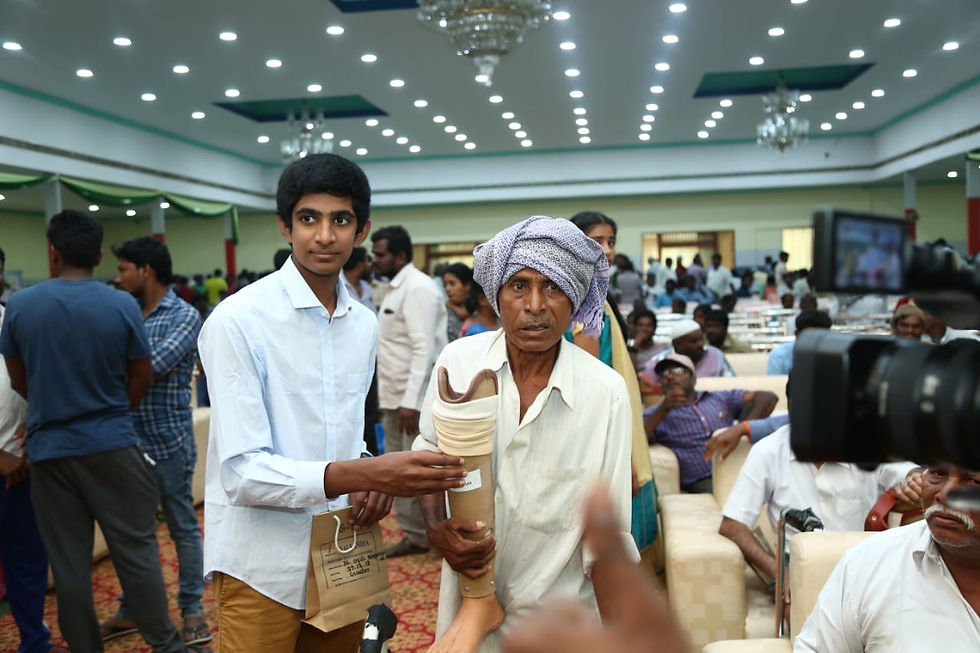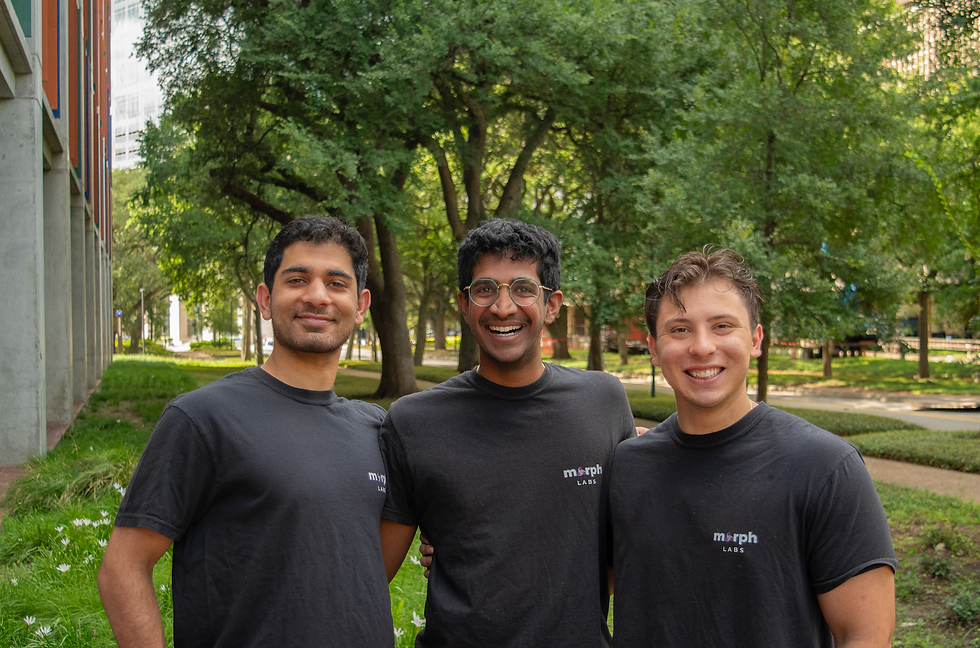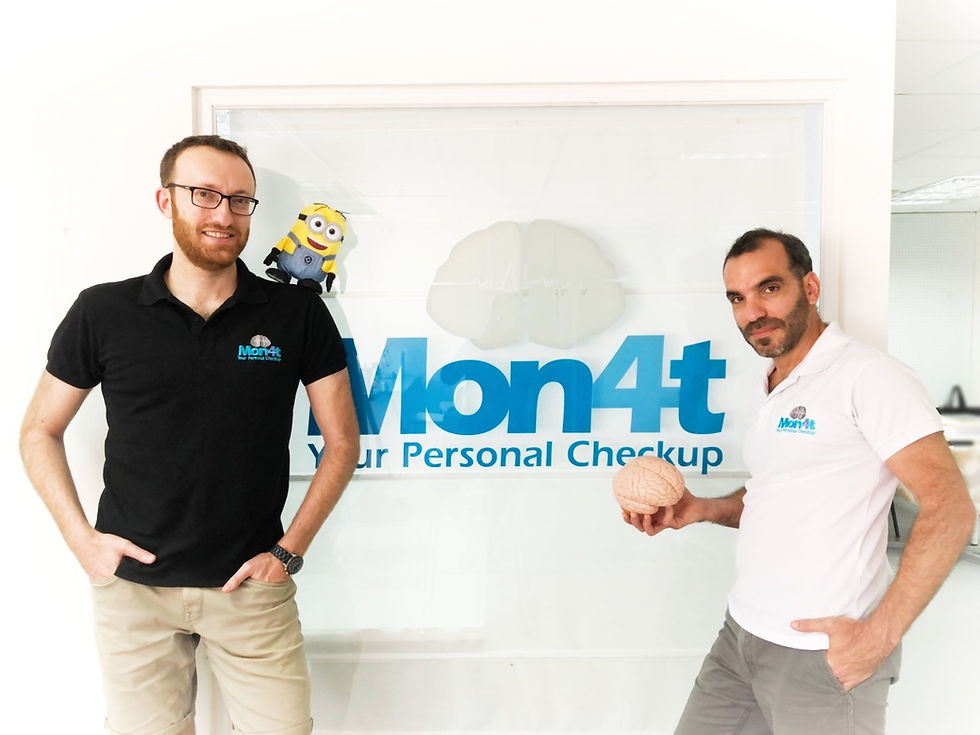How Morph Labs is Building Non-Invasive Telekinesis With Prosthetic Hands
- Dominic Borkelmans

- Sep 8
- 6 min read
Updated: Sep 9
Prosthetic limbs have been around for centuries. But from the wooden feet in ancient Egypt to the mechanical hands developed during the Renaissance, a lot has changed. Now, there are highly technical, robotic solutions that substitute many functions of lost limbs. Yet when bioengineer Pranai Reddy visited rural India on a high school trip, he saw that most amputees still live without any form of prosthetic. The real surprise? This problem isn’t isolated to rural India. In the US, only 56% of the amputees who receive a prosthetic still use it after a year.
Having just graduated from college, Pranai Reddy and his co-founders, Nikola Cadavid and Soham Mehra, started Morph Labs to create prosthetics that are affordable to the masses. But more importantly, they want to create bionic limbs that amputees want to use. That means creating robotic hands that accurately mimic lost function and that can be controlled effortlessly in a non-invasive manner. In simple yet ambitious terms, Morph Labs was founded to ‘build non-invasive telekinesis’.
From Fundraising to Morph Labs
If you imagine the kind of person who would try to revolutionize the prosthetics industry, it would be Pranai. Growing up in a family of physicians and healthcare entrepreneurs, he considered going to medical school while still in high school. But after visiting rural India, he realized there are other ways to improve wellbeing. Shocked by the lack of even basic prosthetics there, he reached out to prosthetics manufacturers in India and organized a fundraiser back in the US. In the end, he helped provide 150 prosthetic limbs for amputees.
Through the philanthropic effort, Pranai got to see the designing and manufacturing of assistive technologies. This sparked an interest in how functionality could not only be restored for those who had lost it but also augmented in able-bodied individuals. He decided against med school and instead went to study Bioengineering at Rice University, conveniently located next to the largest medical center in the world. At Rice, he gained direct access to researchers and clinicians working on assistive medical devices.

Before starting Morph Labs, Pranai built a student venture fund for which he raised $2 million. He led the healthcare sector of the fund, meeting startups in and around the Texas Medical Center. By his senior year at Rice, his exposure to medical devices and experience in venture building naturally converged as he identified one of the biggest problems in upper-limb prosthetics: “many amputees weren’t using them.”
“Initially, I thought it was just the mechanical dexterity of the hands,” Pranai says. “But the real problem is the control system.” The current approach to controlling bionic limbs relies on electromyography (EMG), where muscle signals drive the prosthetic’s movements. But when an amputee has little residual limb and atrophied muscles, those signals are weak and unintuitive. “Imagine flexing your bicep twice to open your hand, or your tricep three times to close it, each time causing pain because those muscles are severely atrophied.”
Pranai and his co-founders began exploring alternative control systems and quickly landed on EEGs. Already used in a range of neurotech applications, EEG has not been widely adopted in prosthetics. “A few research papers had shown some promise, so we pushed that idea further,” Pranai recalls. And so, as they approached the end of their undergraduate studies, they founded Morph Labs.
Toward Human-Level Dexterity in Prosthetic Hands
Morph Labs is swimming against the current. The big BCI players, like Neuralink and Synchron, are taking the invasive route in their neuroprosthetic divisions. But Pranai believes the incumbents are missing the mark. “Amputees have already been through surgery. They don’t want another one just to control their limb,” he says, always keeping end users in mind. “Most amputees want to completely disassociate from the problem when they’re not using their prosthetic. Being able to take something on and off is hugely important.”
This insight led the team to begin developing their proprietary EEG headset. While many EEG headsets already exist, none were deemed sufficiently optimized for the motor cortex or stimulating movement. Traditional EEG caps may spread 32 electrodes across the entire scalp; Morph, by contrast, plans to pack 512 electrodes directly over the motor cortex.

The biggest challenge with EEGs is signal noise and instability, especially since the headset must function during all sorts of everyday activities. To address this, Morph is pursuing a dual-probe setup: one set of electrodes contacts the scalp, capturing both signal and noise, while another set hovers just above the skin, capturing only noise. Subtracting the two and applying machine learning algorithms leaves a rich signal robust enough to drive fine motor control.
Pranai and his cofounders were equally dissatisfied with today’s prosthetic hardware. Most bionic limbs achieve six to eight degrees of freedom, far short of the twenty-plus of a natural hand. “We’re shooting for 19 degrees of freedom,” he says. “The reason other companies haven’t pursued 19 is that their control systems aren’t accurate enough to harness that many degrees of freedom. We believe we can actually utilize all 19.” Morph also sees potential to attract humanoid robotics companies with that level of dexterity.

Guided by Experience, Driven by Youth
At Morph Labs, Pranai wants to push the envelope on every front. Yet, he and his co-founders are only just graduating from college. “There’s some skepticism, like, ‘Is this kid BS’ing me?’” Pranai admits. “But the proof is there. We’re not inventing something entirely new. We’re taking proven elements from across the industry, learning from past failures, and building a solution that hasn’t been done before.”
Supported by seasoned technical advisors, the team is moving quickly in the right direction. In the past month, they managed to manufacture a functioning prototype for under $1,000. While the final, ready-to-market version will inevitably cost more, Morph Labs still expects to price their devices far below the $70–80k retail price of current bionic limbs. “Our goal is to get this on as many amputees as possible to build a strong data flywheel, and that means keeping the price accessible,” Pranai says.
The commercial product is still very much in development. “Right now, we can classify five different gestures using our current ‘scrappy’ headset,” Pranai explains. “Our second-generation headset, built entirely in-house, is about a month away. Even so, we’ve already proven we can classify gestures despite noise, thanks to our machine learning model. The next iteration will be much, much better.”
A Brighter Future for 20 Million Amputees
Pranai hopes the first Morph hands will be sold by March next year. To get there, the team still needs to clear quality and safety testing and scale up manufacturing. Pranai is actively raising funds to finance these ambitions. For now, Morph’s focus remains on upper-limb prosthetics. But as Pranai notes, “The technology isn’t limited to prosthetics. As soon as we have an opportunity to commercialize elsewhere and it makes sense for us, we’ll do it.”
With more functional, comfortable, and affordable solutions in development, Pranai envisions a brighter future for amputees, a population of 20 million people worldwide. “In the next 5-10 years, I think amputees will be much more comfortable using advanced bionic limbs,” he says. “In five years, I think we’ll be able to say: we do non-invasive telekinesis.”
As adoption grows, costs should fall further. The team currently aims to price their devices at no more than 30% of existing options. That still keeps them out of reach for the lower-resource communities Pranai first encountered in high school, but he is clear on the path forward. “For now, going after the American market and getting insurance reimbursement will let us scale. Eventually, that’s how we improve enough to serve those communities effectively.”

About the Founder
Pranai Reddy is the Co-Founder and CEO of Morph Labs. He studied Bioengineering at Rice University, where he gained direct exposure to medical device research and commercialization at the Texas Medical Center. Before starting Morph, he co-founded the Rice Student Venture Fund and raised $2 million, focusing on healthcare startups. Inspired by early philanthropic work providing prosthetics to amputees in rural India, Pranai turned his focus to creating affordable, non-invasive, and intuitive prosthetic solutions.
About the Firm
Founded in 2024 by Pranai Reddy, Nikola Cadavid, and Soham Mehra, Morph Labs is developing non-invasive, EEG-based control systems for advanced upper-limb prosthetics. By combining high-density brain signal capture with machine learning, Morph aims to deliver prosthetic hands with up to 19 degrees of freedom at a fraction of today’s costs. Based in NYC, the company is building toward their first commercial sales in 2026, with a long-term vision of making advanced bionic limbs accessible to amputees worldwide.
Visit: https://www.morphlabs.tech/



